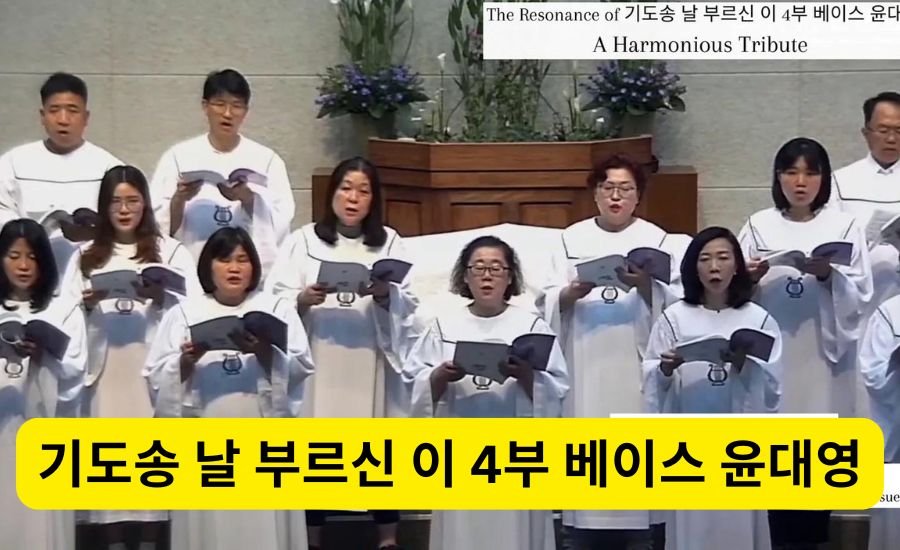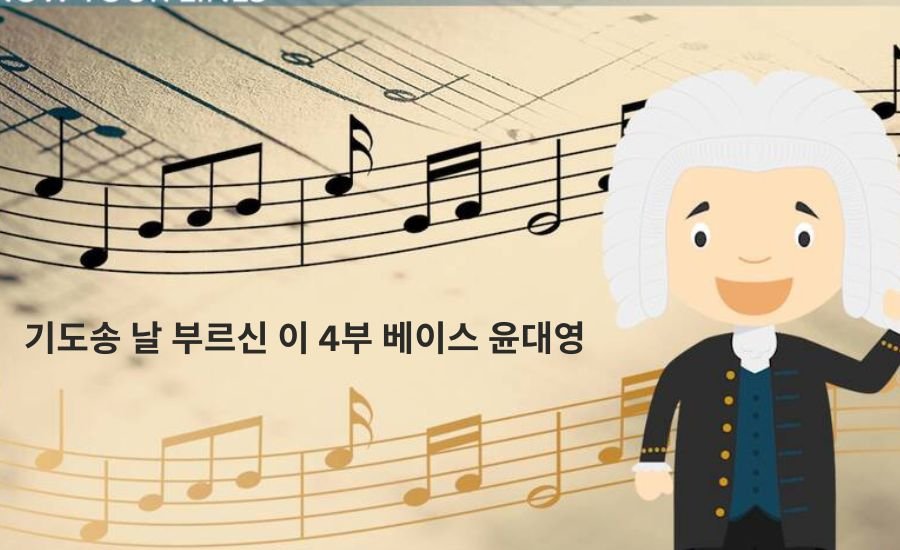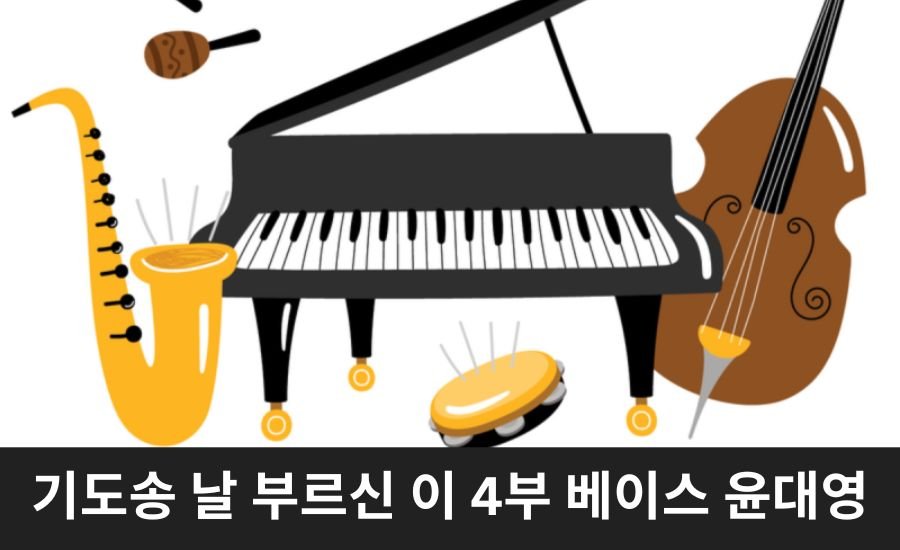Introduction
In the rich tapestry of Korean sacred music, few pieces resonate as profoundly as “기도송 날 부르신 이 4부 베이스 윤대영.” This hymn, performed by the renowned Yoon Dae-Young, stands out not only for its melodic beauty but also for its deep spiritual significance. This article delves into the layers of meaning behind this traditional Korean hymn, the unique role of Yoon Dae-Young in its performance, and the broader impact of this work on choral music.
The Essence of “기도송 날 부르신 이” and Its Cultural Significance

Unveiling the Spiritual Core of the Hymn
“기도송 날 부르신 이,” which translates to “Prayer Song – The One Who Called Me,” is a hymn that reflects the essence of Korean spirituality. Rooted in traditional Korean hymns, this piece encapsulates themes of divine calling and devotion. The hymn’s lyrics express a profound surrender to a higher power, a central theme in Korean sacred music that resonates deeply with its listeners.
The Role of Yoon Dae-Young in Enhancing the Hymn
Yoon Dae-Young, a distinguished bass singer, brings unparalleled depth to “기도송 날 부르신 이.” His performance in the four-part harmony version of the hymn showcases his exceptional skill in choral music. Yoon’s deep, resonant bass voice adds a layer of gravity and solemnity, elevating the spiritual experience of the piece.
Understanding Four-Part Harmony in Sacred Music

The Art of Four-Part Harmony
Four-part harmony is a fundamental aspect of choral music, involving the blending of soprano, alto, tenor, and bass voices. This technique creates a rich, layered sound that enhances the emotional and spiritual impact of the music. In “기도송 날 부르신 이,” the four-part harmony is meticulously crafted, with each voice part contributing to a harmonious and spiritually uplifting experience.
The Unique Contribution of the Bass Voice
In four-part harmony, the bass voice provides the foundation of the music. Yoon Dae-Young’s bass part in “기도송 날 부르신 이” plays a crucial role in adding depth and resonance. His performance underscores the hymn’s spiritual message, creating a powerful emotional connection with the audience.
The Journey of Yoon Dae-Young: From Early Beginnings to Mastery
Early Influences and Musical Training
Yoon Dae-Young’s journey as a choral musician began early in his life. Born into a musically inclined family, he was exposed to the world of music from a young age. His early training focused on developing his vocal abilities, particularly in mastering the bass voice. This foundation prepared him for his acclaimed performance in “기도송 날 부르신 이.”
Spiritual Influence and Artistic Interpretation
Yoon’s spiritual beliefs have profoundly influenced his musical approach. His interpretation of “기도송 날 부르신 이” is more than a technical performance; it is a spiritual expression. Yoon’s ability to convey the emotional and spiritual depth of the hymn through his bass voice demonstrates his profound connection with the music.
The Emotional and Cultural Impact of “기도송 날 부르신 이”
Resonance with Listeners
The emotional impact of Yoon Dae-Young’s performance is evident in the reactions of listeners. Many have shared how the hymn has touched their lives, offering comfort and deepening their spiritual connection. The deep tones of Yoon’s bass voice resonate on a profound level, drawing listeners into a reflective and contemplative state.
Influence on Modern Korean Sacred Music
“기도송 날 부르신 이 4부 베이스 윤대영” has left a lasting mark on Korean sacred music. Its use of four-part harmony and its deep spiritual message have inspired other musicians and composers. The hymn’s influence extends beyond its own performance, contributing to the development of a vibrant tradition of sacred music in Korea.
The Legacy and Future of Korean Sacred Music
The Enduring Appeal of Traditional Korean Hymns
The continued relevance of “기도송 날 부르신 이” highlights its enduring appeal. This hymn, with its rich harmonies and spiritual depth, remains a cherished part of the Korean sacred music repertoire. Its impact on listeners and its contribution to the genre underscore the timeless nature of traditional Korean hymns.
Looking Ahead: The Future of Sacred Music in Korea
As Korean culture and spirituality continue to evolve, so will its sacred music. The legacy of “기도송 날 부르신 이 4부 베이스 윤대영” will undoubtedly influence future generations of musicians and composers. New works will build upon this foundation, reflecting the changing spiritual landscape of Korea.
Conclusion
“The Resonance of 기도송 날 부르신 이 4부 베이스 윤대영” stands as a monumental piece in Korean sacred music, showcasing the profound impact of traditional hymns performed with exceptional artistry. Yoon Dae-Young’s masterful interpretation adds a deep layer of emotion and spirituality to the hymn, exemplifying the rich tradition of Korean choral music. The intricate four-part harmony enhances the hymn’s message, creating a powerful and resonant experience for listeners. As Korean sacred music continues to evolve, the legacy of this hymn will undoubtedly inspire future generations, ensuring its place in the heart of Korean spirituality and choral artistry. Through its timeless appeal and emotional depth, “기도송 날 부르신 이” remains a cherished and influential work in the sacred music repertoire.
FAQs
Q: What makes “기도송 날 부르신 이 4부 베이스 윤대영” significant in Korean sacred music?
A: “기도송 날 부르신 이” is significant for its deep spiritual message and its use of four-part harmony. Performed by Yoon Dae-Young, the hymn reflects themes of devotion and divine calling, resonating deeply with listeners.
Q: Who is Yoon Dae-Young, and what is his role in the hymn?
A: Yoon Dae-Young is a renowned bass singer known for his exceptional performance of “기도송 날 부르신 이.” His bass part provides depth and gravitas to the hymn, enhancing its spiritual impact.
Q: Why is four-part harmony important in sacred music?
A: Four-part harmony enriches sacred music by creating a layered, complex sound. Each voice part contributes to the overall texture, with the bass providing stability and depth, thus enhancing the emotional and spiritual experience of the music.
Stay informed with the latest news and updates on viralzee.com


